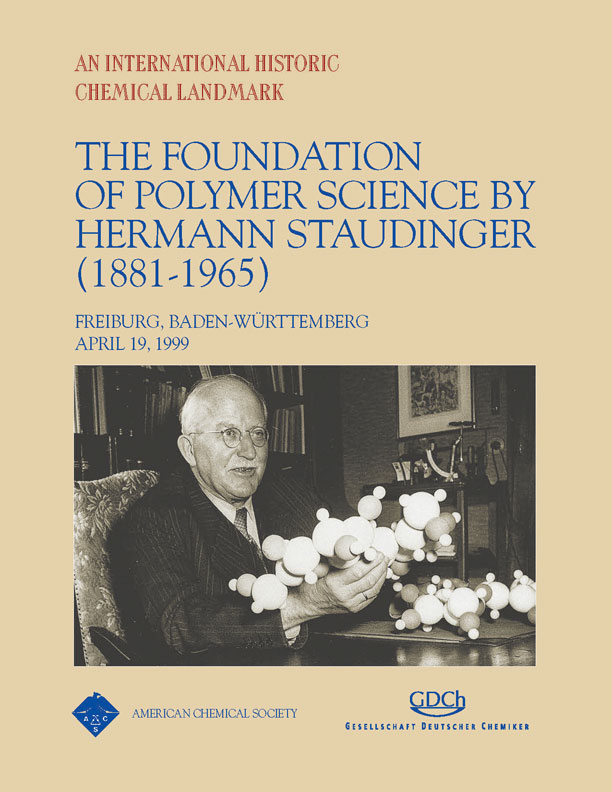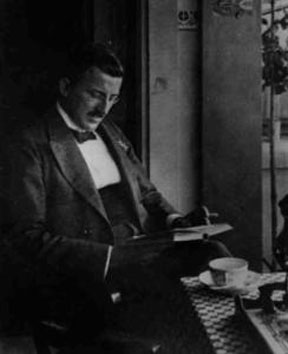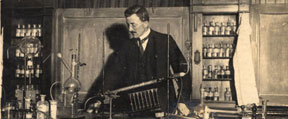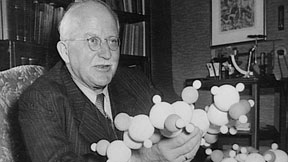Hermann Staudinger and the Foundation of Polymer Science
Dedicated April 19, 1999, at the Hermann Staudinger House at the Institute of Macromolecular Chemistry in Freiburg, Baden-Württemberg, Germany.
Hermann Staudinger’s pioneering theories on the polymer structures of fibers and plastics and his later research on biological macromolecules formed the basis for countless modern developments in the fields of materials science and biosciences and supported the rapid growth of the plastics industry. For his work in the field of polymers, Staudinger was awarded the Nobel Prize for chemistry in 1953.
Contents
Hermann Staudinger: Father of Macromolecular Chemistry
In 1920, Hermann Staudinger, then professor of organic chemistry at the Eigenössische Technische Hochschule in Zurich, created a stir in the international chemical community when he postulated that materials such as natural rubber have very high molecular weights. In a paper entitled "Über Polymerisation," Staudinger presented several reactions that form high molecular weight molecules by linking together a large number of small molecules. During this reaction, which he called "polymerization," individual repeating units are joined together by covalent bonds.
This new concept, referred to as "macromolecules" by Staudinger in 1922, covered both synthetic and natural polymers and was the key to a wide range of modern polymeric materials and innovative applications. Today, the molecular architectures of synthetic polymers and biopolymers are tailored with high precision to meet the demands of modern technology. The products of polymer chemistry are diverse, from food packaging, textile fibers, auto parts and toys, to membranes for water desalination, carriers used in controlled drug release and biopolymers for tissue engineering.
Staudinger's concept, however, represented a strong challenge to his contemporaries. The scientific community was very reluctant to admit the existence of extremely large compounds with molecular weights exceeding 5000. Instead, micelle-type aggregates, as observed for soap molecules, were considered to account for the unusual properties of such materials. Moreover, some scientists were convinced that the size of a molecule could never exceed the size of the unit cell, as measured by X-ray crystallography.
Staudinger, following the scientific tradition of classical organic chemistry, presented sound experimental evidence to support the existence of high molecular weight polymers. He selected natural rubber as the model system because Carl Harries and Rudolf Pummerer had suggested independently that natural rubber consisted of aggregated small cyclic polyisoprene units via "partial valencies" associated with the double bonds. Such aggregates should have been destroyed when the double bonds were removed by hydrogenation. Staudinger's hydrogenation experiments showed that hydrogenated rubber was very similar to normal unsaturated rubber.
During the late 1920s, Staudinger provided additional evidence based on viscometry to confirm that molecular weights remained unchanged during chemical modification of polymers.
Despite the impressive experimental evidence, Staudinger continued to encounter very strong opposition from leading organic chemists for nearly two decades. For instance, Heinrich Wieland, 1927 Nobel laureate in chemistry, wrote to Staudinger, "Dear colleague, drop the idea of large molecules; organic molecules with a molecular weight higher than 5000 do not exist. Purify your products, such as rubber, then they will crystallize and prove to be low molecular compounds!"
In his autobiography, Staudinger commented: "My colleagues were very skeptical about this change, and those who knew my publications in the field of low molecular chemistry asked me why I was neglecting this interesting field and instead was working on a very unpleasant field and poorly defined compounds, like rubber and synthetic polymers. At that time the chemistry of these compounds often was designated, in view of their properties, as Schmierenchemie ('grease chemistry')."
Staudinger never ceased to promote his concepts of polymer sciences, despite his colleagues' mistrust of many of his methods and results. In lively discussions, he eloquently defended his ideas against all attacks using his ingenuity, persistence and pronounced enthusiasm. By the end of the 1920s and during the 1930s, Staudinger's macromolecular concept found increasing acceptance by other chemists. Although some of his opponents still maintained their objections, his concept was already being applied in industrial processes.
At long last, on December 10, 1953, Staudinger received his reward for the concept of macromolecules and his prolonged effort to establish the science of large molecules when he was awarded the Nobel Prize for chemistry.
Polymer Landmarks
The links below will direct you to more National Historic Chemical Landmarks about developments in polymer chemistry and production:
Bakelite®: The World’s First Synthetic Plastic
Biography of Hermann Staudinger
Hermann Staudinger was born in Worms on the Rhine on March 23, 1881. Because he loved plants and flowers, he studied botany under Georg Klebs at the University of Halle after graduating from high school in 1899. His father suggested that he take some chemistry courses to get a better understanding of botany. Following this paternal advice, Hermann studied chemistry at the Universities of Halle, Darmstadt and Munich. Chemistry became his main interest, and in 1903 at the age of 22, he took his Ph.D. under Daniel Vorländer in Halle.
He continued his research in organic chemistry in the laboratory of Johannes Thiele at the University of Strasbourg. During his investigations of carboxylic acid compounds, he discovered the highly reactive ketenes. In 1907, immediately after completing his postdoctoral work on the ketenes, Staudinger, at the age of 26, was appointed full professor at the Technical University of Karlsruhe, succeeding Roland Scholl. In Karlsruhe, he met eminent chemists such as Carl Engler and Fritz Haber, the later founder of high-pressure chemistry. At that time, Staudinger's research focused on ketene chemistry, reactions of oxalyl chloride, aliphatic diazo compounds and preparation of butadiene and isoprene.
In 1912, Richard Willstätter, a world leader in organic chemistry, was appointed director of the newly founded Kaiser Wilhelm Institute for Chemistry in Berlin-Dahlem. The Eigenössische Technische Hochschule in Zürich offered his vacated chair in chemistry to Staudinger, who had just published his first book, Die Ketene. In Zurich, Staudinger continued his research on organic synthesis. In addition, he started to investigate physiologically active natural compounds. With Leopold Ruzicka (who would win the Nobel Prize for chemistry in 1939), Staudinger identified the structure of natural pyrethrins and developed synthetic routes to these important natural insecticides.
During World War I, Staudinger also conducted research into ersatz compounds, substitutes for natural products that were in short supply during the war. In addition to the successful development of synthetic pepper, Staudinger and Thadaeus Reichstein carried out the difficult analysis of natural coffee aroma. Eventually, they came up with a credible ersatz aroma (furfuryl mercaptan with traces of methyl mercaptan), which was converted into an industrial process.
During this period, Staudinger was a typical practitioner of mainstream organic chemistry, which was already a highly sophisticated and respected science, led by chemists such as Adolf von Baeyer, Emil Fischer and Richard Willstätter. By 1914, organic chemists had prepared more than 100,000 synthetic compounds used for various applications, including dyes and pharmaceuticals. Although not yet 40, Staudinger was considered a leading organic chemist. During the 1920s, Staudinger decided to leave the safe and prestigious haven of classical organic chemistry to embark on the stormy high seas of polymer science. Staudinger's pioneering spirit drove him to break away from the typical thinking of traditional organic chemists and to advance new and revolutionary ideas.
In 1926, he was appointed to a chair at Albert Ludwigs University in Freiburg, where he dedicated all his efforts to establishing and expanding the frontiers of polymer science. His research topics included natural rubber, cellulose and synthetic polymers such as polyoxymethylene, polystyrene and polyethylene oxide, which Staudinger considered to be model systems for the much more complex biopolymers. As well as making synthetic polymers, Staudinger tried to determine the molecular weights of polymers by using end-group analysis, by measuring the viscosity of polymer solutions, and by using electron microscopy analysis.
Hermann Staudinger always maintained a close relationship with industry to obtain funds for his research and to act as a technical consultant for firms interested in plastics and rubber. For many years, the "Förderverein" (association of supporters) of the Institute for Macromolecular Chemistry linked the research managers of the various companies who sponsored polymer research in Freiburg. Staudinger's internal group seminar, which started in 1950, attracted both academic and industrial chemists, and it soon became the largest German annual polymer meeting with more than 700 participants during the 1990s.
Staudinger's research was published in more than 800 publications amounting to more than 10,000 printed pages. He summarized his research in his autobiography, Arbeitserinnerungen (From Organic Chemistry to Macromolecules) published in 1970. His collected works, entitled Das Wissenschaftliche Werk von Hermann Staudinger (The Scientific Contributions of Hermann Staudinger), were edited by Magda Staudinger and published between 1969 and 1976.
For many years, Staudinger's textbook, entitled Die hochmolekularen organischen Verbindungen Kautschuk und Cellulose (The High Molecular Weight Organic Compounds Rubber and Cellulose), published in 1932 by Springer in Berlin, was the "bible" of many academic and industrial scientists. In 1947, Staudinger inaugurated the new journal Makromolekulare Chemie with Wepf & Company, publishers in Basel. For more than 50 years, this journal has provided an excellent forum for scientific exchanges and has promoted the expansion of polymer science.
Staudinger also was concerned with moral and political issues outside the scope of academic chemistry. During World War I, he publicly criticized chemical warfare and opposed his old friend Fritz Haber, who had developed poison gas to support the German war effort. In 1917, Staudinger published a paper, based on a calculation of the industrial balance between the warring powers, in which he stated that the war was lost to Germany and should be stopped immediately, as any further bloodshed was senseless. His courageous statements were in direct opposition to the nationalist spirit of that period.
Staudinger's quest for peace meant that his patriotism was called into question many times. In fact, in 1934, during the Nazi period, the dean of Freiburg University, the famous German philosopher Martin Heidegger, initiated dismissal procedures against Staudinger. Although Staudinger was interrogated by the Gestapo and had to resign, his removal was postponed, and finally withdrawn, when he agreed to stop questioning Nazi authority in public. Even so, all of his requests to travel abroad to attend conferences were rejected after 1937.
Industrial Significance of Polymer Science
During the late 19th century, cellulose derivatives were developed as artificial substitutes for silk and ivory. However, the real breakthrough in industrial production occurred in 1908, when Leo Hendrik Baekeland developed phenolic resins as the first true synthetic polymer, which became known as Bakelite®.
No other materials can match the versatility of polymeric materials. Because of their molecular architectures, they can variously be stiff, soft or elastic; permeable or impermeable; and transparent or opaque. Moreover, polymers are relatively inexpensive. Because of their versatility, synthetic polymers have myriad applications. Some are very familiar: packaging, toys, furniture and fabrics. Others are less visible, including circuit boards, composites for space ships, and medical uses such as absorbable sutures and implant materials.
Many polymeric materials can be readily recycled by remolding recycled polymer pellets or by heating the polymer to recover the feedstock. For example, commodity polyolefins, such as polypropylene, are cracked at temperatures above 400° C to form synthetic oil and gas, which can replace natural oil and gas in refineries and energy production.
Moreover, light polymeric materials can save weight in automotive and airplane construction, thus reducing fuel consumption and exhaust emission. As thermal insulators, polymer foams help to conserve energy. The petroleum used to make polymers, which is 4% of all consumption, saves more than 10% of all the petroleum used because of the improved insulation and weight-reduction in automotive construction made possible by these polymers. Polymeric materials are prime examples of environmentally friendly materials that help protect fossil resources for future generations.
Bakelite®
Around 1907, Belgian-born chemist Leo Hendrik Baekeland took two ordinary chemicals, phenol and formaldehyde, mixed them in a sealed autoclave, and subjected them to heat and pressure.
The sticky, amber-colored resin he produced in his laboratory was the first plastic ever to be created entirely from chemicals, and the first material to be made entirely by man. Dr. Baekeland's new material — he called it Bakelite — opened the door to the Age of Plastics.
Learn more about Bakelite®, a National Historic Chemical Landmark.
Macromolecules: A Bridge between Material Sciences and Life Sciences
The development of polymer sciences stimulated the production of new materials with a wide variety of applications in high technology. As early as 1926, Staudinger emphasized the significance of macromolecules for biochemistry and biology. His intention, supported by his wife, Magda, was to create a new research discipline of macromolecular bioscience or, as we would call it today, macromolecular life science. He concluded his Nobel Prize acceptance speech by describing his vision: "In the light of new insights in macromolecular chemistry, the miracle of life shows an exceptional multitude and perfection of architectures characteristic of living matter."
Nature uses a very small number of monomers, such as amino acids and saccharides, to produce a large variety of biopolymers with specific functions in cell structures, transport, catalysis and replication. Today, innovations in life sciences, especially biotechnology, will continue to stimulate the creation of new synthetic biopolymers, with unprecedented control of molecular architectures and biological activities.
Further Reading
- Historische Statten der Chemie (Gesellschaft Deutscher Chemiker)
- Hermann Staudinger Biography (nobelprize.org)
- Hermann Staudinger (Chemical Heritage Foundation)
Landmark Designation and Acknowledgments
Landmark Designation
The American Chemical Society and Gesellschaft Deutscher Chemiker dedicated The Foundation of Polymer Science by Hermann Staudinger (1881-1965) an International Historic Chemical Landmark on April 19, 1999, in Freiburg, Baden-Württemberg, Germany. The English version of the plaque commemorating the event reads:
This building is named after Hermann Staudinger, who, between 1926 and 1956, carried out his pathbreaking research on macromolecular chemistry in Freiburg. His theories on the polymer structures of fibers and plastics and his later research on biological macromolecules formed the basis for countless modern developments in the fields of materials science and biosciences and supported the rapid growth of the plastics industry. For his work in the field of polymers, Staudinger was awarded the Nobel Prize for chemistry in 1953.
Acknowledgments
Adapted for the internet from “The Foundation of Polymer Science by Hermann Staudinger," produced by the National Historic Chemical Landmarks program of the American Chemical Society in 1999.
Back to National Historic Chemical Landmarks Main Page.
Learn more: About the Landmarks Program.
Take action: Nominate a Landmark and Contact the NHCL Coordinator.





